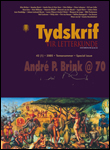"It is much more complicated and much more fluid than mere linearity" Female genealogies in André Brink's Imaginings of Sand
DOI:
https://doi.org/10.4314/tvl.v42i1.29695Keywords:
André Brink, Imaginings of Sand, female genealogy, male gazeAbstract
One of the subversive strategies of Brink in Imaginings of Sand (1996) is his rewriting of male history as a female genealogy. Genealogy is the instrument which confers legitimacy and controls the transfer of authority and property through various judicial processes. In this way he extends the boundaries of what it means to be 'male' by adopting a female persona, although one might argue that his male gaze nevertheless shows in his 'female' narratives. This raises the vexed question whether a man is 'allowed' to adopt, what is often perceived as an appropriation of, a female voice. We are formed by the texts and discourse surrounding and determining us, but we also become the authors of our own stories, at least if we are not prepared to accept the existing norms and conventions. But in South Africa, where the 'real' story has been obliterated by the years of apartheid and exile, transmitted traditional stories need to be questioned radically. Brink's postmodern novel, like his "Bird House" is one of those spaces over which the narrative has lost control, but precisely by exploring an "other-than-themselves" which has been "coded as feminine, as woman" it attempts to re-question "the major topics of that philosophy: Man, the Subject, Truth, History, Meaning".
Downloads
References
...
Downloads
Published
Issue
Section
License
Copyright (c) 2005 Tydskrif vir Letterkunde

This work is licensed under a Creative Commons Attribution-ShareAlike 4.0 International License.


 https://orcid.org/0000-0001-6465-6584
https://orcid.org/0000-0001-6465-6584


.png)